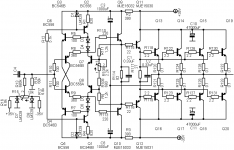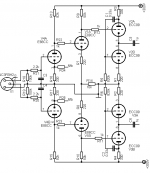With this much complexity and so many semiconductor junctions in the signal path - why bother with the extra complexity of a differential tube front end?
Do not worry the solid state beast!
I recently moved over from a darlington to a triple darlington output stage and sonically it was a big advantage. With the much increased current gain the (tube) VAS is freed from output loading effects. For my amplifier I have measured the current gain: 6.4M. So 1 uA base current in the pre-driver is enough to source 6.4A to the load.
Peter
Regarding Hybrids
The most important places to have tubes are where an amp
must interface with signal peaks or load reactances beyond
the control of the amp's internal design. The input and output.
The inner stages of an amp deal with signals of known limits
and are unlikely to misbehave. Sand (done right) if fine here.
I wound not classify a tube pre-amp with clearly separate
sold-state final a "Hybrid". I see no inseparable synergy of
Tube and Solid here that makes this a Hybrid.
Let us remember that valves usually react to plate voltage
as well as grid (and screen), and interact with the load in
complex and pleasing ways. It is an equation with at least
2 variables of voltage input for one current output.
Most solid state dumbs this down to a single current or
voltage input (and junction temperature) for one current
out. The only interaction with the load is ugly clipping.
And if feedback is abused, poor recovery.
I see no tube (or tubelike behavior) in this output that
takes over before anything nasty can happen. Unless
you are assured of a purely resistive load, I don't think
you can garauntee this amp will behave as well as a
tube or true Hybrid.
Putting a tube in the front end is only half the battle.
----------------------------------------------------------------------
What is the purpose of C3 & C6 1000uF?
Are you bootstrapping here to widen the effective rail?
Beware of amplifiers driving capacitive loads....
As I see no global feedback loop, it might be alright.
Depending how you were planning to servo out
the bridge, that capacitance might yet become a
feedback loop problem...
The most important places to have tubes are where an amp
must interface with signal peaks or load reactances beyond
the control of the amp's internal design. The input and output.
The inner stages of an amp deal with signals of known limits
and are unlikely to misbehave. Sand (done right) if fine here.
I wound not classify a tube pre-amp with clearly separate
sold-state final a "Hybrid". I see no inseparable synergy of
Tube and Solid here that makes this a Hybrid.
Let us remember that valves usually react to plate voltage
as well as grid (and screen), and interact with the load in
complex and pleasing ways. It is an equation with at least
2 variables of voltage input for one current output.
Most solid state dumbs this down to a single current or
voltage input (and junction temperature) for one current
out. The only interaction with the load is ugly clipping.
And if feedback is abused, poor recovery.
I see no tube (or tubelike behavior) in this output that
takes over before anything nasty can happen. Unless
you are assured of a purely resistive load, I don't think
you can garauntee this amp will behave as well as a
tube or true Hybrid.
Putting a tube in the front end is only half the battle.
----------------------------------------------------------------------
What is the purpose of C3 & C6 1000uF?
Are you bootstrapping here to widen the effective rail?
Beware of amplifiers driving capacitive loads....
As I see no global feedback loop, it might be alright.
Depending how you were planning to servo out
the bridge, that capacitance might yet become a
feedback loop problem...
Re: Regarding Hybrids
Yes C3 and C6 do boostrapping. But I think that the are not pure cpacitive loads. The load is the two resistor (R2&R3) they coupled to the output of the amplifier.
I attached the tube input schematic.
Sajti
kenpeter said:What is the purpose of C3 & C6 1000uF?
Are you bootstrapping here to widen the effective rail?
Beware of amplifiers driving capacitive loads....
As I see no global feedback loop, it might be alright.
Depending how you were planning to servo out
the bridge, that capacitance might yet become a
feedback loop problem...
[/B]
Yes C3 and C6 do boostrapping. But I think that the are not pure cpacitive loads. The load is the two resistor (R2&R3) they coupled to the output of the amplifier.
I attached the tube input schematic.
Sajti
Attachments
- Status
- This old topic is closed. If you want to reopen this topic, contact a moderator using the "Report Post" button.
- Home
- Amplifiers
- Tubes / Valves
- One more hybrid idea

